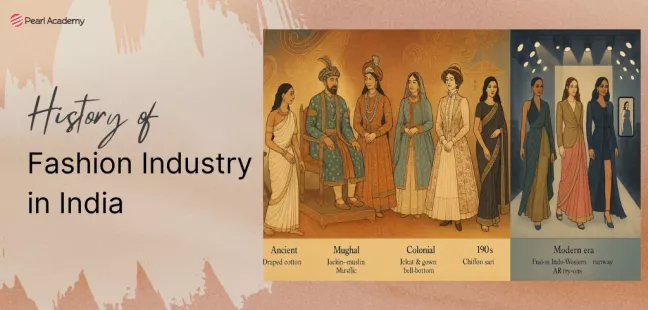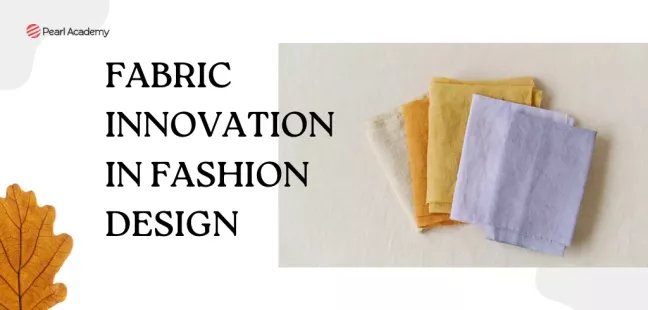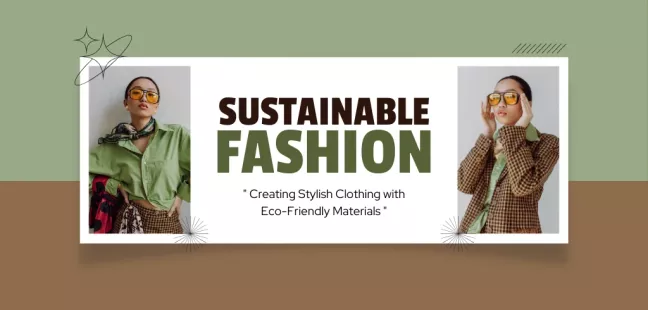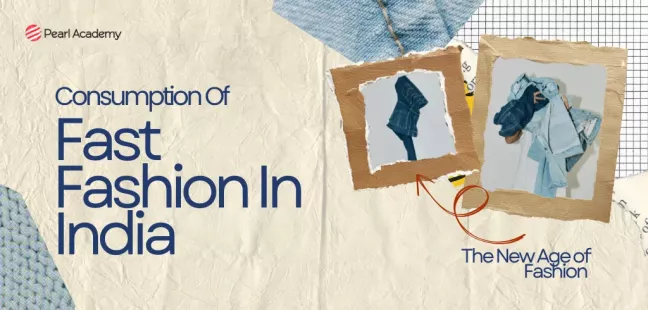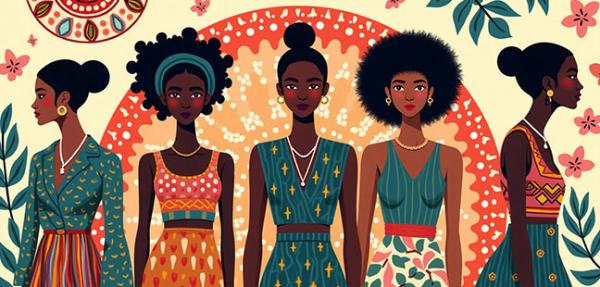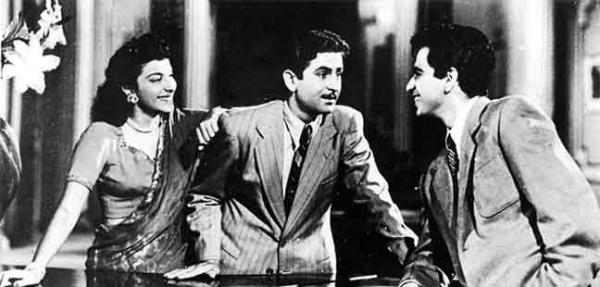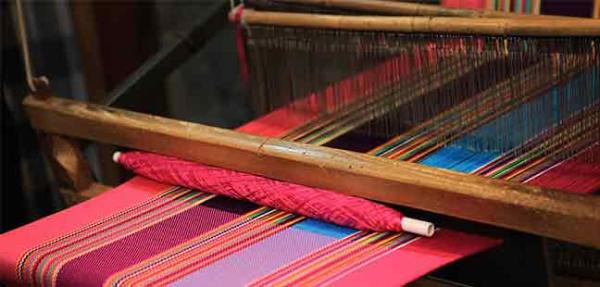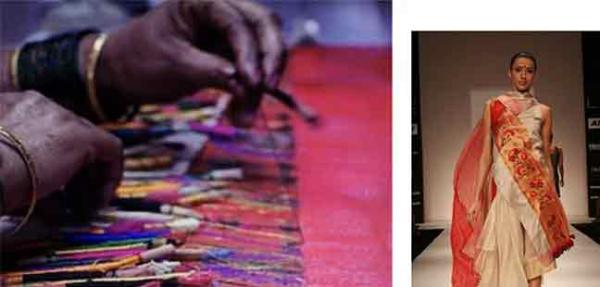Growth Trends in the Indian Textile Industry
- Editorial Team
- Published 04-Jan-2025
.webp)
We will always need clothes! The textile industry is an ever-growing sector that has shown remarkable expansion in recent years and continues to evolve. With changing consumer preferences and technological advancements, two key shifts in the industry are cost-effectiveness and sustainability.
In this blog, we explore must-know growth trends shaping the future of India's textile industry.
Become future-ready with our Fashion Programs
Know MoreInteresting Facts about Indian Textile Industry:
- India ranks 2nd in Textile and Clothing export in the world, as per reports by Textile Ministry.
- The textiles and apparel industry contributes 2.3% to the India’s GDP and 12% to total exports.
- The Indian Textile industry provides jobs to approximately 45 million people, making it second-largest source of employment post agriculture.
- India produces 70% of the world’s jute and is the second-largest producer of silk and fiber globally.
- The textile and apparel sector provides jobs to 27 million women in India.
5 Must Know Growth Trends in the Indian Textile Industry
1. Increase in Demand for Natural Fibres
The textile industry is increasing the production of clothing made from natural fibers like cotton, silk, linen, wool, jute, and cashmere to promote sustainability. Even plastic waste is now being recycled into fabric!
Businesses are shifting from a linear to a circular model, reinventing the entire value chain—from raw material sourcing and production to supply chain management and waste recycling. This comprehensive approach makes sustainability an integral part of the Indian textile sector’s future.
2. Non-Woven Fabrics are Now the Go-To!
Non-woven fabrics are made using short or continuous long threads joined by specialized techniques. They can be disposable or durable, offering qualities such as absorbency, strength, and liquid repellence.
These fabrics have transformed industries, much like how Henry Ford made cars accessible or how the Wright brothers revolutionized air travel.
Popular Non-Woven Products:
- Home & Furnishings: Bed linen, carpet backing, laundry dryer sheets
- Medical & Hygiene: Diapers, medical textiles, PPE kits
- Technology & Utility: Heat/electricity conductive fabric, industrial filters
3. Rise in Digital Textile Printing
Small textile businesses can now fulfill smaller orders efficiently with Digital Textile Printing (DTP). This inkjet-based process allows businesses to print colorants directly onto fabric, reducing waste and minimizing costs. Unlike traditional rotary screens, digital designs can be updated or corrected in real time on a computer, making it a flexible and sustainable solution for textile printing.
4. Advancements in Technology
Many dye plants depend on state-provided electricity, leading to frequent power outages due to high consumption. This challenge has been addressed through thermal energy solutions. Boilers generate heat that powers dyeing machines, stenters, dryers, and thermic fluid heaters, improving efficiency and reducing electricity dependency.
5. Promoting Health and Hygiene with Medical Textiles
India has emerged as the world’s second-largest producer of PPE, with over 600 certified companies manufacturing these essential products. The global PPE market is projected to grow from $52.7 billion in 2019 to more than $92.5 billion by 2025. (Source: https://www.investindia.gov.in/sector/textiles-apparel)
Medical Textiles must be non-allergic, non-carcinogenic, non-toxic, antistatic in nature, and biocompatible. Keeping these requirements in mind, Indian Textile Industry has now increased and improved its production of medical textiles with the help of Sensor-Based Smart Medical Textiles, Antimicrobial Medical Textiles and Compostable Medical Textiles.
The development of smart textiles and biocompatible materials is revolutionizing the market by providing expanded capabilities such as real-time monitoring and better integration with human tissues.
Textile Design Courses in India
With strategic moves in the right direction, you can be part of India’s second-largest employment-generating sector. Government initiatives like 'Make in India' and rising demand in fashion and home textiles make Textile Design a promising career path.
Which degree is best for the Textile Industry?
Pursue B.Des. in Textile Design: A Bachelor's degree in Textile Design offers an in-depth understanding of textiles, their role in fashion, interiors, and automotive industries, and their increasing global demand.
Students gain knowledge of both technical and creative aspects of textiles, fostering independent problem-solving and design thinking. The course also explores the intersection of digital and physical textiles, focusing on smart textiles and advanced technology in the industry.

Student Guidance Center: Our Counselors are Just a Click Away.
Key Takeaways:
The Indian textile industry is witnessing tremendous growth, driven by sustainability, technological advancements, and global demand for eco-friendly textiles. With increasing exports and a dynamic domestic market, the industry is ripe with opportunities for innovation in design, material science, and manufacturing.
For students passionate about fashion and textile innovation, pursuing a B.Des in Textile Design offers a gateway to this evolving industry, blending creativity with technical expertise. Now is the time to be at the forefront of textile design evolution—embrace the future of textiles!
Tags
- #Fashion
Pearl Admission Enquiry
Trending Post
-
![https://pearlwebsitecdn-prod-d8bgbfaqbgcghcfw.a01.azurefd.net/drupal-files/2025-12/Top-fashion-desiging-colleges-in-india_1024x490-3.webp https://pearlwebsitecdn-prod-d8bgbfaqbgcghcfw.a01.azurefd.net/drupal-files/2025-12/Top-fashion-desiging-colleges-in-india_1024x490-3.webp]()
-
![https://pearlwebsitecdn-prod-d8bgbfaqbgcghcfw.a01.azurefd.net/drupal-files/2025-12/Whats-the-Difference-Between-a-Fashion-Designer-a-Fashion-Entrepr-3.webp https://pearlwebsitecdn-prod-d8bgbfaqbgcghcfw.a01.azurefd.net/drupal-files/2025-12/Whats-the-Difference-Between-a-Fashion-Designer-a-Fashion-Entrepr-3.webp]()
What’s the Difference Between a Fashion Designer & a Fashion Entrepreneur?
2025-11-08By Editorial Team
-
![https://pearlwebsitecdn-prod-d8bgbfaqbgcghcfw.a01.azurefd.net/drupal-files/2025-12/7-things-know-decide-fashion-designer_1024x490-3.webp https://pearlwebsitecdn-prod-d8bgbfaqbgcghcfw.a01.azurefd.net/drupal-files/2025-12/7-things-know-decide-fashion-designer_1024x490-3.webp]()
Subscribe to Pearl Blogs
By clicking the "Subscribe" button, I agree and accept the privacy policy of Pearl Academy.





















